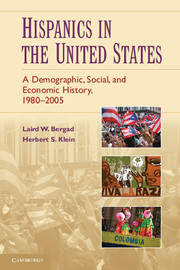Book contents
- Frontmatter
- Contents
- List of Graphs, Tables, and Maps
- Introduction
- 1 Immigration to the United States to 1980
- 2 The Hispanic Population to 1980
- 3 Population Growth and Dispersion, 1980–2005
- 4 The Demography of the Hispanic Population
- 5 Wealth and Poverty
- 6 Educational Attainment
- 7 Citizenship, the Latino Electorate, and Voter Participation
- 8 Occupational Structures, Employment, and Unemployment
- 9 English Language Abilities and Domestic Usage
- 10 Hispanic Business Ownership
- 11 Race
- 12 Endogamous and Exogamous Marriage Patterns among Latino Household Heads
- 13 Conclusion
- Bibliography
- Index
- References
Introduction
Published online by Cambridge University Press: 05 June 2012
- Frontmatter
- Contents
- List of Graphs, Tables, and Maps
- Introduction
- 1 Immigration to the United States to 1980
- 2 The Hispanic Population to 1980
- 3 Population Growth and Dispersion, 1980–2005
- 4 The Demography of the Hispanic Population
- 5 Wealth and Poverty
- 6 Educational Attainment
- 7 Citizenship, the Latino Electorate, and Voter Participation
- 8 Occupational Structures, Employment, and Unemployment
- 9 English Language Abilities and Domestic Usage
- 10 Hispanic Business Ownership
- 11 Race
- 12 Endogamous and Exogamous Marriage Patterns among Latino Household Heads
- 13 Conclusion
- Bibliography
- Index
- References
Summary
At the beginning of the 21st century the Hispanic, or Latino, population of the United States replaced African Americans as the single largest minority in the country and they are projected to increase to about 30% of the national population by 2050 according to the latest U.S. Census Bureau estimates. The Hispanic presence in the United States has a long historical tradition, even though it has been only recently that their demographic, economic, cultural, and political importance has received a great deal of public attention. With the end of the Mexican-American War in 1848, or the War of U.S. Intervention as it is referred to in Mexico, the United States absorbed a large Mexican population into its national borders in the Southwest and in California. Additionally, from the early 19th century on there was a small but steady stream of migrants from the Hispanic Caribbean who settled mainly in the states of New York and Florida. This included both political exiles fleeing a repressive Spanish colonialism, which lasted until 1898 in Cuba and Puerto Rico, and the migration of Cuban tobacco workers to the cigar industry that developed in Florida, principally in the Tampa Bay area. There was also a significant migration of Mexican workers from the late 19th century until the Second World War who labored in a variety of economic sectors from agriculture to railroad building, mainly in the Southwestern states along the Mexican border. Much of this migration was seasonal rather than permanent as these workers usually returned to their homes in Mexico rather than settling in the United States.
Thus, the presence of Hispanics within the United States is not a new phenomenon nor should it be considered unexpected given the common border with Mexico and the political and economic power wielded by the United States in the Americas. What changed during the 20th century was the extraordinary growth of migration from the region in the aftermath of World War II until today, as well as the impressive natural demographic increase of the resident Latino population. Moreover unlike earlier migrations from Europe or Asia to the United States, the settlement patterns of Latin American and Caribbean migrants and their offspring have been more evenly spread across the United States from 1980 on. While the Hispanic population had traditionally been concentrated in the Southwestern states, California, New York, and Florida, by 2010 Latinos had spread in significant numbers to nearly every area of the nation.
- Type
- Chapter
- Information
- Hispanics in the United StatesA Demographic, Social, and Economic History, 1980–2005, pp. 1 - 8Publisher: Cambridge University PressPrint publication year: 2010



